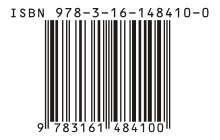The International Standard Book Number, ISBN, is a unique[1] commercial book identifier barcode. The ISBN system was created in the United Kingdom, in 1966, by the booksellers and stationers W.H. Smith.

Originally, it was the 9-digit Standard Book Numbering (SBN) code and still was used in 1974; it was adopted as the international standard ISO 2108 in 1970. A similar, numeric identification, the International Standard Serial Number (ISSN), identifies periodical publications such as magazines. Since January 1, 2007, ISBNs are of 13 digits, like in Bookland EAN-13.[2] The TC 46/SC 9 is responsible for the standard.
What is the international book publishing certificate?[3]
The international book publication certificate is originally issued by the international organization and institution that is the custodian and producer of the ISBN code. The international certificate of book publication is an online certificate that can be easily inquired about the authenticity of the certificate online with the certificate number in it.
The ISBN number that is present in all books should not be confused with the international certificate of book publication. All books must have an ISBN number, but international book certificates cannot be obtained for all books.
For what books can an international book publishing certificate be obtained?
To receive this certificate, the most important criteria of the publisher's credibility is measured as follows: the number of indexing of the publisher in articles and international forums related to the publisher's documentation. The higher the number, the higher the chance of receiving a certificate. The fact that you have just published a book and taken a isbn will not lead to the issuance of a certificate from isbn-international.com. This site is very strict in reviewing.
And the next criterion is the author, which is of course the next most important.
When the publisher's documentation is strong, the probability of issuing a certificate increases.
Of course, receiving the certificate is not certain.
Overview
An ISBN is given to each edition and variation (except reprintings) of a book. The ISBN is 13 digits long if assigned after January 1, 2007, and 10 digits long if assigned before 2007. An International Standard Book Number consists of 4 or 5 parts:
- for a 13 digit ISBN, a GS1 prefix: 978 or 979
- the group identifier code, (group of countries sharing a language)[4]
- the publisher code,
- the item number, and
- a checksum character or check digit.
The ISBN parts may be of different lengths, and usually are separated with hyphens or spaces.[5]
The group identifier code (GIC) number is 0 or 1 for English-speaking countries; 2 for French-speaking countries; 3 for German-speaking countries; 4 for Japanese; 5 for Russian, et cetera. The original standard book number (SBN) had no group identifier, but affixing a zero (0) as prefix to a 9-digit SBN creates a valid 10-digit ISBN. The group identifier may be up to 5 digits long; e.g. 99936 is a group identifier for the country Bhutan.[6]
The national ISBN agency assigns the publisher number (cf. the category: ISBN agencies); the publisher selects the item number. Generally, a book publisher is not required to assign an ISBN, nor for a book to display its number (except in China; see below), however, most book stores only handle ISBN bearing merchandise.
A listing of all the 628,000 assigned publisher codes is published, and can be ordered in book form,[7] but, as of 2007, it costs US$300. The web site of the international ISBN agency does not offer any free method of looking up publisher codes.
Related pages
- Amazon Standard Identification Number (ASIN)
- CODEN (serial publication identifier currently used by libraries; replaced by the ISSN for new works)
- Digital Object Identifier (DOI)
- European Article Number (EAN)
- International Standard Audiovisual Number (ISAN)
- International Standard Music Number (ISMN)
- International Standard Recording Code (ISRC)
- International Standard Serial Number (ISSN)
- International Standard Musical Work Code (ISWC)
- Library of Congress Control Number
- PMID (PubMed ID)
- Serial Item and Contribution Identifier (SICI)
Footnotes
Other websites
Wikiwand in your browser!
Seamless Wikipedia browsing. On steroids.
Every time you click a link to Wikipedia, Wiktionary or Wikiquote in your browser's search results, it will show the modern Wikiwand interface.
Wikiwand extension is a five stars, simple, with minimum permission required to keep your browsing private, safe and transparent.
